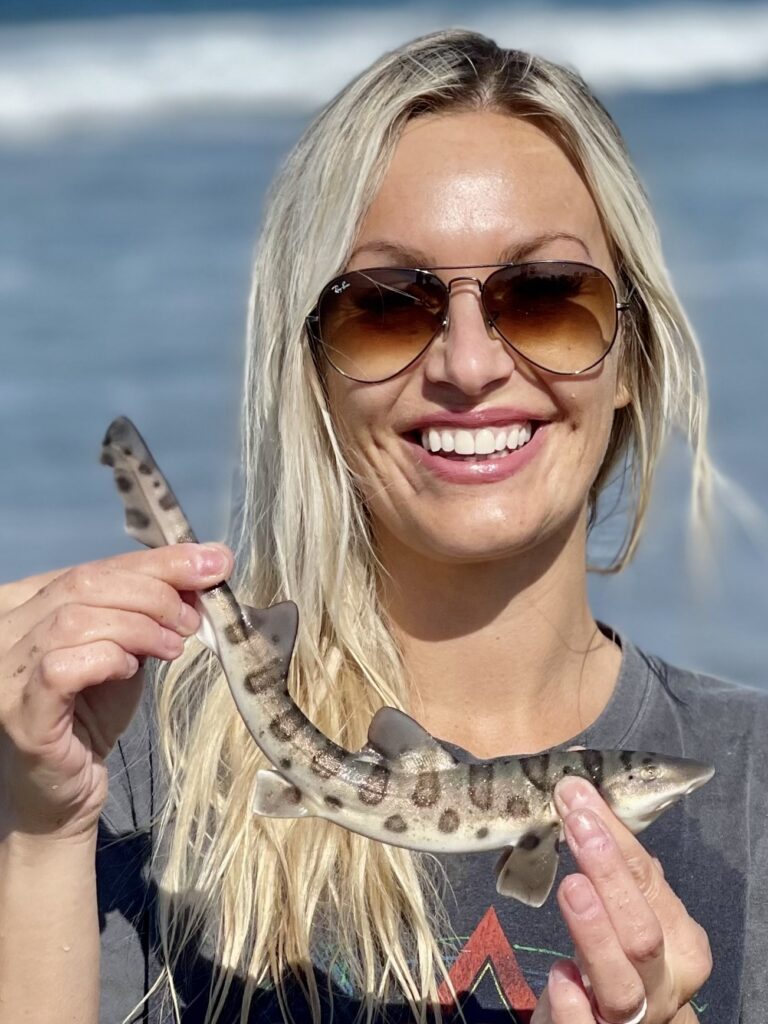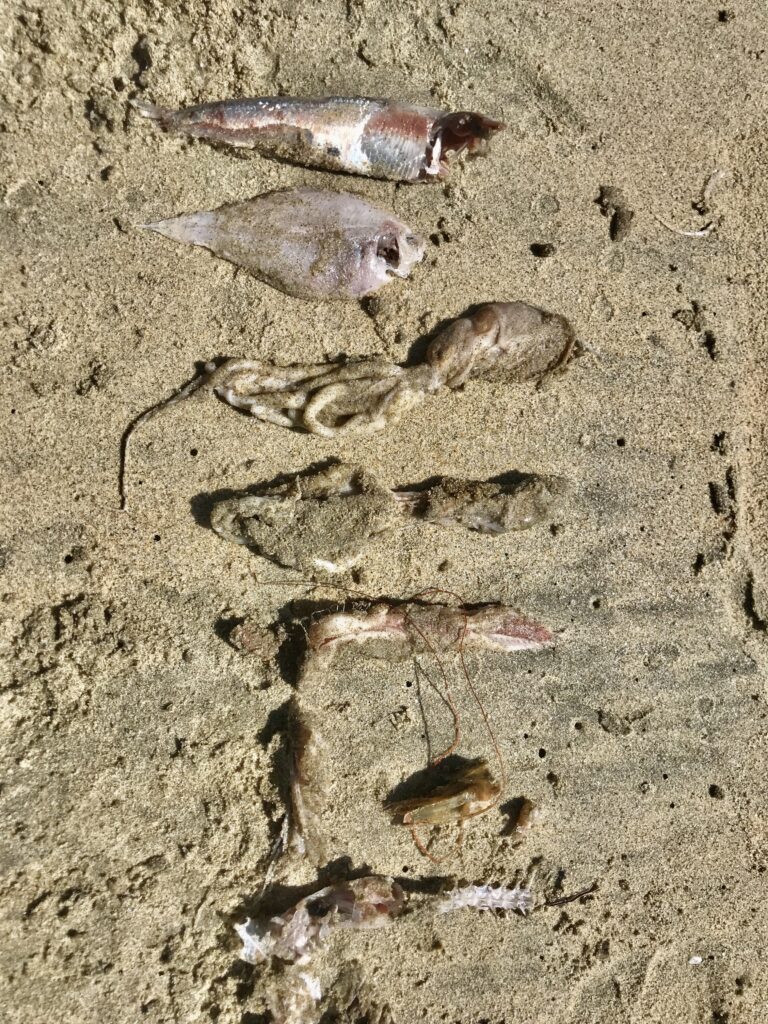BY BEN HERVEY-MURRAY
Leopard sharks are the rockstars of the surf fishery in Southern California, providing arm-testing sport in their larger grades across beaches, bays and harbor systems during warmer months. Plus they look fantastic – they’re one of the most striking fish you can catch on the West Coast. With prime leopard season upon us, let’s look at the process of catching and releasing big leopard sharks from the beach.
Locations for leopard sharks
One of the first rules of hunting any specific species is working out the locations where they hunt, feed and live. For leopard sharks, this means understanding a couple of key aspects of their lifecycle.
To be clear, I’m not interested in targeting smaller leopards – the trophy grade is 50 inches or above with a ceiling of around 63 inches – which is important to understand because smaller, juvenile examples have a different life cycle to the larger adults. Smaller ones seem to be present year-round across SoCal, whereas the larger 50-inch-plus females are not.
So, what to look for when trying to locate prime areas for big leopard sharks? Basic requirements include a sandy beach, preferably with a reef or kelp system nearby, with some sort of large harbor or inlet in the vicinity and moving water. Think of somewhere like Mission Bay in San Diego or the harbor systems around San Diego, LA, Long Beach, Santa Monica Bay, Monterey and San Francisco and you’re on the right track.
The reasons for this specific location are twofold; the larger females are highly focused on giving their young the best chance of survival, and enclosed areas with warm water and lots of small food items (crabs, worms, shrimp etc) provide ideal habitat for baby leos. They are viviparous, which means they give birth to live young, so situating themselves where their young will thrive is a great advantage to furthering their genetic lineage. If you’ve ever caught a tiny leopard shark, this is likely only a few weeks or months old, and popped straight out of the womb ready to hunt.
Big female leopards, in my experience, are often carrying young when they’re above 50 inches in length, and finding these safe, shallow sandy beaches is their main focus in life. Thus, targeting the bigger samples involves identifying these holding areas.
The second reason for their preference to hang out on shallow sandy beaches is water temperature. Leopards are highly focused on finding the warmest water possible and during the summer months, the beaches, bays and harbors will hold water in the 63- to 72-degree mark, which is the ideal temperature window for the species.
Studies have shown that leopards migrate towards warmer water, often traveling for many miles up and down the coast to find areas with elevated temperatures. The prevailing theory behind this migration is one of thermoregulation – keeping their body temperature elevated for as long as possible. This aids with digestion, growth rates and reproduction – again, giving their young the best chance of survival.
So, following the water temperature trends across the California coastline via the NOAA (National Oceanic and Atmospheric Administration) measuring stations is a great way of working out the likelihood of a successful leopard session once you have a likely area or two earmarked. Water temperatures above 63 degrees and rising or holding steady? Game on. Falling temperatures or below 63 degrees? Not so great for the big girls.
Anyone interested in studying this subject further should look up the 2016 paper by Nosal et al that lays out some interesting theories and data around this subject, as does a 2007 study by Hight et al. Reading these really helped me understand the species and some of their behavioral quirks that led to some very successful seasons chasing big leopards.
Best leopard shark baits
This is probably the number one area where anglers struggle when it comes to this style of fishing. Leopards, like all sharks and rays, have a highly-developed olfactory system, giving them the ability to sense tiny chemical signatures in the water such as blood. They’re infrequent visual hunters and are much more likely to find food by picking up a scent trail in the current and following it to source.
The crux is this: you must use fresh bait when targeting big leopard sharks. Bait quality matters – they want sushi, not bait-shop-freezer offerings. You may well catch the odd one on a hunk of frozen bait, but having fished fresh and frozen baits back to back on a number of occasions, I can honestly say that fresh bait massively outfishes frozen every single time.

The reason for this is that a fresh bait contains fully intact cells full of amino acid proteins, but the freezing process breaks down these cells into lifeless mush, hence the squidgy nature of frozen bait. The leopard’s highly developed olfactory senses have evolved to pick up on tiny chemical signatures in the water – amino acids given off by prey items, for example.
So a bait laden with fresh shark-attracting, amino-packed blood and flesh will be infinitely more attractive compared to a frozen offering that has little of the good stuff left to leech out into the water and offers very little attraction to the picky leos.
During the warmer months, which is the key period for leopard fishing anyway, mackerel are found in abundance on nearly every pier in California and there is no better big leopard bait than half a medium-size mackerel freshly caught that day or the night before, and kept in an airtight ziplock bag on ice in a cooler or fridge set to just above zero degrees centigrade.
Small bonito, large sardines, Spanish mackerel, chunks of tuna, yellowfin croaker head sections and surf perch are also great fresh bait options, with croaker and perch working well in cooler conditions. Squid is OK as a last resort but suffers from being almost always frozen and pretty soft, making it ray fodder rather than a reliable shark bait.
I’ve had the opportunity to examine the stomach contents of a couple of leopards and both were a surprising mix of sand dabs, some sort of large sardine-type bait fish, shrimp and hand-size squid. This might lead us to conclude they’re opportunistic feeders, eating whatever fresh goodies come their way via olfactory-based hunting, and also shows the variety of habitats they frequent during a 24-hour period. They’re not living in the surf zone all the time, but use frequent forays inshore to feed, hence the importance of laying down fresh scent trails from sushi–grade bait for them to find when they do come within casting range.
Rigs and tackle
The first rule of leopard shark fishing is to not go under-gunned. The tactics described above will likely also attract other critters in the shark and ray family, some of which may be significantly larger; soupfin sharks, big bat rays and so on. When you’re targeting species like this, it’s your responsibility to ensure every fish you hook reaches the beach and is carefully unhooked with minimum damage and time out of water.
Thus, the minimum tackle I’d target big leopards with is a 12 or 13-foot surf spinning rod rated to cast 6- to 8-ounce sinkers, combined with a 6000 or 8000-size spinning reel loaded with at least 40-pound braid, or 50- to 60-pound if fishing near reefs or rocky ground when you need to bully the fish a little more. Add an 80-pound mono top shot or casting leader to this for abrasion resistance and casting.

A quick note about casting; learn to cast a big sinker (8-ounces) and bait properly with a few field-based practice sessions. You’ll appreciate this when it comes to a cast that really matters and you’re less likely to make a mess of the process in front of your friends. Trust me on this one.
Please don’t try West Coast shark fishing with weaker tackle or you will experience breakages and losses, particularly if you try and fish straight braid or light mono down to the rig. Sharks have a tendency to get wrapped up and will make short work of braid main line and lesser mono when its tight to their skin, leaving them rig with a rig and sinker attached.
Rig-wise, the ever-reliable pulley rig equipped with twin 8/0 or 10/0 circle hooks and at least 130-pound wire leader and 200-pound mono rig body is a very reliable performer, especially combined with a 6- to 8-ounce wired surf sinker.
The twin hooks are important due to a quirk of the leopard shark’s feeding habits; they have a strong tendency to pick up a bait like a dog with a stick, running with it for a few seconds without taking the whole meal down. This produces the classic bendo bite without a hook-up more often than not if you’re using a single hook rig.
By contrast, the bottom hook on the twin hook set up snares them perfectly in the corner of the mouth nine times out of ten, with the larger models taking the whole bait down and tripping up on the top hook. Double circle hooks massively increases hook-up ratios without a doubt. The use of high quality circle hooks avoids deep hooking and makes for quick and easy unhooking on the beach. Please don’t use J hooks or mono leaders.
Conditions
You’ll find feeding leopard sharks in a variety of conditions but the number one factor in triggering the bigger fish to come into the surf zone to hunt is undoubtedly the state of tide. They want water moving – usually an hour or two either side of high or low tide – and a bit of current is an advantage in helping them find food.

As discussed, they find their food mostly by sensing chemical signatures in the water – your fresh, bleeding bait, for example. Tidal flow and current helps disperse these telltale signs of food far and wide, so if you’re a shark entering the surf zone where someone may be fishing, you’re far more likely to home in on a hook bait emitting blood thanks to the current.
Now consider a period of zero current or slack tide around a high or low – there’s little water movement to bring those scent trails within easy reach of the fish. Clearly they’ve learnt to hunt when the tide is at its peak flow to make finding food as easy as possible. Maximum chance of a meal, minimum effort.
A quick word about current, too. This is often caused by a larger swell moving water around the Pacific beaches and it can be a challenge to hold bottom. Always use a wired sputnik sinker and be prepared to zip-tie the arms in place so they don’t break out and cause you to not hold bottom. A tall, sturdy sand spike made from white 1.5” PVC is also an aid in this regard.
For 90% of my leopard shark fishing, I use 7- and 8-ounce sinkers to hold the bait in place, right where the shark expects to find it after swimming up that tasty scent trail coming from the fresh bait. Not holding bottom will cost you fish, and lead to more kelp issues and frequent recasts. Swell-wise, anything in the 1- to 3-foot range is usually easily fishable and leopards have no problem in hunting and feeding in big swell and heavy current. Learn to handle both and your catch rate will improve.
Handling
There’s a good chance the big leopard you’ve just caught is pregnant, and should be handled as such. Assuming you’ve got the leopard in close to shore, maybe just beaching itself in a few inches of water as the surf sucks out – first, move in and grab the tail with both gloved hands and skim back along the damp sand and out of the shorebreak. Keep clear of the head end at this stage.
Straddle the shark by putting a knee either side of the body, forming a tunnel between your legs. Just hover above the shark, don’t sit on it. This allows you to grab the head with the shark unable to thrash or move too much, aiding easy removal of the circle hook, which is almost always in the corner of the mouth or bottom jaw. Always carry good gloves, pliers and cutters, should they be needed for any reason.
With the hook out and tackle moved to one side (don’t stand on that wired surf sinker…) you have just enough time for a quick photo before carefully wading back out to a decent depth of water, say a foot or so, and holding that tail until it gives a good kick and swims off. Nine times out of ten, they’re ready to go as soon as they’re back in the water but occasionally a few seconds of recovery is needed to get orientated and swimming again.
My number one rule when releasing any sort of shark or ray in the surf is that I want the water moving out when I release that fish. Timing is everything. Watch those little waves coming towards you and wait until the water is visibly moving out before letting go of that tail – get this bit wrong and the water will push the fish back towards you, leaving you prone to an ankle bite. Been there, got the scars.

As a final note, a mature female leopard shark is likely well over a decade old and several sources cite the species as having high concentrations of toxins due to their longevity and diet. So, please practice and release with these amazing sharks and leave those big girls to reproduce so this unique species is around for a few more million years.
Get your taco meat somewhere else and just enjoy catching and releasing one of the ocean’s best looking fish.
Ben is a professional licensed guide specializing in surf and inshore species such as leopard sharks. Check out www.americanseafishing.com for details on guided trips and more info on recommended tackle for surf sharks in California.





